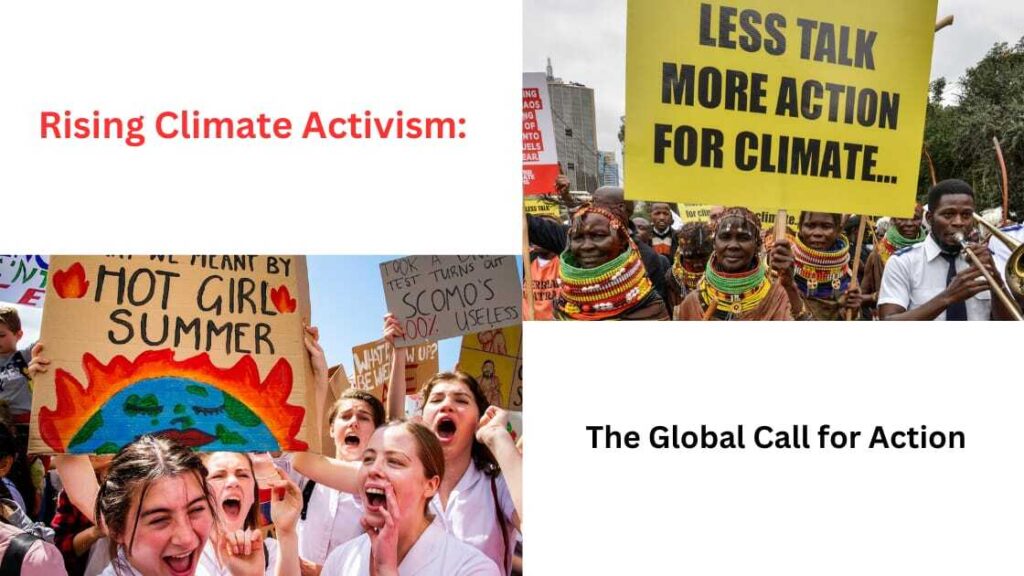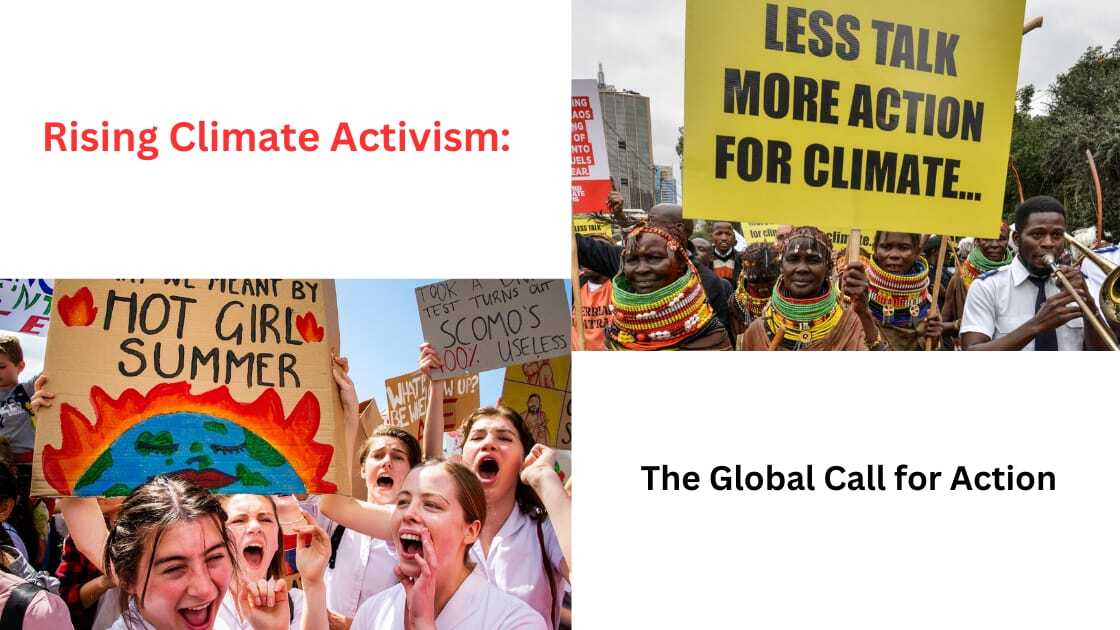
Introduction
As the world grapples with the accelerating effects of climate change protests, climate activism has surged to the forefront of global discourse. With increasing temperatures, rising sea levels, and more frequent extreme weather events, the urgency of addressing environmental challenges has intensified. A powerful movement led by activists, organizations, and everyday citizens has emerged, demanding immediate and sustained action from governments, businesses, and individuals. This piece delves into the origins, evolution, key players, tactics, and impact of global climate activism, as well as the challenges it faces in a complex, ever-evolving global landscape.
1. Origins of Climate Activism for Climate Change Protests
Climate activism has roots going back to the environmental movements of the 1960s and 1970s, when concerns about air pollution, deforestation, and chemical contamination sparked widespread public awareness. Key milestones in the history of climate activism include:
Earth Day (1970): The first Earth Day, held in the U.S., was one of the largest environmental protests in history, signaling the beginning of modern environmentalism. Millions of people participated in events calling for cleaner air, water, and natural spaces.
The UN’s Intergovernmental Panel on Climate Change (IPCC) Formation (1988): The creation of the IPCC marked the institutionalization of climate concerns at a global level, as it provided scientific assessments on climate change protests, its risks, and potential responses.
Kyoto Protocol (1997): A landmark international treaty aimed at reducing carbon emissions, the Kyoto Protocol saw activists pushing governments to meet global targets for greenhouse gas reductions.
While these early efforts laid the groundwork, the climate activism of today has taken on an urgency not seen before.
2. The Evolution of Climate Activism for Climate Change Protests”
Climate activism has evolved in response to increasing environmental degradation, the availability of new scientific data, and the rising visibility of climate disasters. The modern climate movement can be broken down into several key phases:
The Rise of Environmental NGOs: In the 1980s and 1990s, non-governmental organizations (NGOs) such as Greenpeace, the World Wildlife Fund (WWF), and Friends of the Earth emerged as key players in advocating for climate policies, using strategies such as lobbying, education campaigns, and protests.
Climate Justice Movement: In the 2000s, a more radical phase of activism emerged with the climate justice movement. This movement shifted the focus from purely environmental concerns to include social, racial, and economic justice, particularly for marginalized communities disproportionately affected by climate change protests.
Youth-Led Movements: Today, climate activism has become increasingly driven by young people, many of whom feel that older generations have failed to act decisively. This can be seen with the global prominence of Greta Thunberg and the school strike movement she inspired, as well as the rise of groups like Fridays for Future and Extinction Rebellion.
3. Key Players in Climate Activism for “Climate Change Protests”
The fight against climate change has seen the participation of a diverse range of actors, including:
Grassroots Movements: From local environmental advocacy groups to large-scale international protests, grassroots organizations have mobilized millions of people to demand climate action. Movements like Fridays for Future and People’s Climate March are prime examples of how collective action at the local level can resonate globally.
Environmental NGOs: Organizations such as Greenpeace, WWF, and the Sierra Club play a significant role in shaping environmental policies, challenging corporate practices, and conducting campaigns to educate the public on climate issues.
Youth Activists: Figures like Greta Thunberg, Vanessa Nakate, and Autumn Peltier have become symbols of a new generation of activists. Youth movements have pressured governments and institutions to recognize the existential threat climate change poses to future generations.
Indigenous Leaders: Indigenous communities have long been at the frontlines of environmental protection, particularly in defense of forests, rivers, and land rights. Indigenous activists from regions such as the Amazon, the Arctic, and Pacific islands are critical voices in the global climate movement, emphasizing the intersection of climate action and indigenous sovereignty.
4. Tactics and Strategies
Climate activism employs a wide array of tactics and strategies, both traditional and innovative. Some of the most prominent include:
Protests and Strikes: Large-scale demonstrations such as the People’s Climate March and Fridays for Future school strikes have garnered global attention and mobilized millions of participants. Climate Change Protests are designed to apply public pressure on policymakers to enact more ambitious climate goals.
Civil Disobedience: Groups like Extinction Rebellion use direct action tactics such as sit-ins, blockades, and nonviolent disruptions to raise awareness of the climate crisis and force governments to respond. Their goal is to provoke public debate and shift political inertia.
Digital Activism: Social media platforms have become vital tools for organizing, spreading awareness, and galvanizing support for climate causes. Activists use hashtags like #ClimateStrike and #FridaysForFuture to unite global participants in virtual spaces, creating a powerful online movement.
Legal Challenges: In recent years, climate activists have increasingly turned to the courts to hold governments and corporations accountable for failing to meet environmental obligations. Landmark cases such as Juliana v. United States and Urgenda Foundation v. The Netherlands have set new precedents in climate litigation.
Corporate Divestment Campaigns: Activists have also targeted the financial sector, pushing universities, pension funds, and corporations to divest from fossil fuels. Campaigns like 350.org’s Fossil Free aim to weaken the economic power of the fossil fuel industry by removing financial investments that support its operations.
5. The Impact of Climate Activism for Climate Change Protests
The rise of climate activism has already had profound effects on public opinion, policy, and corporate behavior:
Shifting Public Awareness: Climate activism has brought the issue to the forefront of public discourse. Polls show that the majority of citizens in many countries now view climate change as a critical issue that requires immediate action. This shift in public consciousness has empowered activists to demand more aggressive policy measures.
Policy Changes: Climate activism has directly influenced national and international policies. The Paris Agreement (2015), aimed at limiting global warming to below 2°C, was a direct result of widespread advocacy and pressure from the climate movement. On the local level, activism has led to cities and regions adopting ambitious carbon neutrality targets.
Corporate Accountability: Activist pressure has pushed corporations to become more transparent about their environmental impact. Many companies, especially in the energy, transportation, and food sectors, have pledged to reduce emissions, transition to renewable energy, and adopt sustainable practices due to activist campaigns.
Youth Engagement: The engagement of young people in climate activism is particularly impactful. By organizing protests, demanding change, and confronting leaders at forums such as the United Nations, young activists have reframed the climate crisis as an issue of intergenerational justice, inspiring a new wave of environmental action.
6. Challenges Facing Climate Activism for “Climate Change Protests”
Despite its successes, climate activism faces significant obstacles:
Political Resistance: In many countries, climate activism or Climate change protests is met with strong opposition from political leaders who prioritize economic growth over environmental protection. Fossil fuel interests often exert considerable influence over policy, delaying necessary reforms.
Corporate Lobbying: The fossil fuel industry continues to invest heavily in lobbying efforts to protect its interests. Companies like ExxonMobil and Chevron have been criticized for obstructing climate policies while publicly claiming to support environmental initiatives.
Disinformation Campaigns: Climate activists are often undermined by disinformation campaigns that seek to cast doubt on the scientific consensus about climate change. Social media has become a battleground for the spread of climate misinformation, with efforts to downplay the urgency of the crisis.
Social and Economic Inequality: Climate change disproportionately affects low-income and marginalized communities, which often lack the resources to adapt to environmental challenges. Activists must navigate the complex intersection of environmentalism and social justice to ensure an inclusive movement that addresses these disparities.
7. Looking Ahead: The Future of Climate Activism for Climate Change Protests
As the global climate crisis intensifies, so too will the activism surrounding it. The future of climate activism is likely to see:
Increased Youth Participation: Young people will continue to lead the charge, using innovative technologies and global networks to push for change. Future activists will likely expand the scope of climate activism to address other pressing environmental issues, such as biodiversity loss and ocean acidification.
Collaborative Movements: Climate activism is expected to grow more collaborative, with environmental groups forming alliances with labor unions, social justice movements, and indigenous rights organizations to create a broad-based coalition for systemic change.
Global Policy Shifts: With mounting public pressure, governments will increasingly adopt more ambitious climate policies, especially as the costs of inaction become more apparent. International cooperation, such as the implementation of the Paris Agreement, will be crucial in preventing the worst outcomes of climate change.
Technological Innovation: Climate activists will likely push for the adoption of new technologies that can help reduce emissions and adapt to climate impacts. From renewable energy advancements to carbon capture and storage, technological solutions will be integral to the movement’s future.
Conclusion
The rise of climate activism reflects a growing global consensus that urgent action is required to combat the climate crisis climate change protests. As activists continue to push for ambitious policies, corporate responsibility, and international cooperation, their efforts will be crucial in shaping the future of our planet. Despite the challenges they face, the resilience and determination of climate activists offer hope that a more sustainable and just world is possible. With the growing momentum of this movement, the call for global action will only intensify in the years to come.
Read More Article Visit : https://todaybloggingworld.com/
